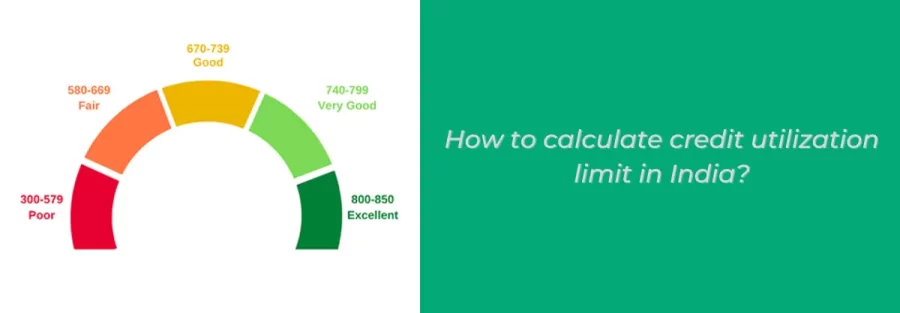How to calculate credit utilization limit in India?
Understanding and managing your credit utilization limit is crucial for maintaining a healthy financial profile in India. Your credit utilization limit refers to the percentage of your available credit that you are currently using. This metric plays a significant role in determining your creditworthiness and can impact your credit score and ability to access loans and credit cards. This article will provide a comprehensive guide on how to calculate your credit utilization limit in India, along with tips to effectively manage and improve your credit utilization ratio. By understanding this concept and implementing the right strategies, you can take control of your credit and pave the way for a stronger financial future.
Defining Credit Utilization Limit:
Credit utilization limit refers to the percentage of your available credit that you are currently using. It is a key factor in determining your creditworthiness and is often used by lenders and credit card companies to assess your financial responsibility.
Significance of Credit Utilization Limit:
Understanding and managing your credit utilization limit is crucial because it can significantly impact your credit score and affect your ability to obtain loans or credit cards. By keeping your credit utilization ratio low, you demonstrate to lenders that you are a responsible borrower.
Impact on Credit Score:
Your credit utilization ratio plays a critical role in determining your credit score. A lower credit utilization ratio indicates that you are using credit responsibly, which can boost your credit score. Conversely, a higher ratio can negatively impact your score and raise concerns about your financial stability.
Influence on Loan and Credit Card Applications:
Lenders consider your credit utilization ratio when evaluating your loan or credit card applications. A high credit utilization ratio may make lenders hesitant to approve your application as it suggests a higher risk of default. On the other hand, a low ratio can improve your chances of getting approved and even result in more favorable interest rates.
Calculating Credit Utilization Ratio:
To determine your credit utilization ratio, you need to divide your total credit card balances by your total credit limits and multiply by 100. This will give you a percentage that represents how much of your available credit you are currently using.
Factors Affecting Credit Utilization Ratio:
Several factors can impact your credit utilization ratio, including outstanding loan balances and credit card balances. It’s important to keep an eye on these balances and make timely payments to maintain a healthy credit utilization ratio.
Step-by-Step Guide to Calculating Your Credit Utilization Limit:
Below is the step by step guide for calculating the credit utilization limit:
Gather Credit Card and Loan Information:
Begin by gathering the necessary information, such as your credit card statements and loan balances. Make sure you have the most recent information available.
Calculate Total Credit Available:
Add up the credit limits of all your credit cards. For example, if you have two credit cards with limits of INR 50,000 and INR 75,000, your total credit available would be INR 1,25,000.
Calculate Total Credit Used:
Next, add up the outstanding balances on all your credit cards and loan accounts. For instance, if your credit card balances amount to INR 20,000 and you have a loan balance of INR 30,000, your total credit used would be INR 50,000.
Determine Credit Utilization Ratio:
Divide your total credit used by your total credit available and multiply by 100. Continuing with the previous example, (50,000 / 1,25,000) x 100, your credit utilization ratio would be 40%.
By following these steps, you can easily calculate your credit utilization limit in India and take the necessary steps to maintain a healthy ratio. Remember, keeping your credit utilization ratio low is essential for your overall financial well-being.
Tips to effectively manage and improve your credit utilization ratio:
Below are the tips to effectively manage and improve your credit utilization ratio:
Pay down outstanding balances:
Let’s start with the most obvious tip: pay down those outstanding balances! The lower your balances, the lower your credit utilization ratio will be. So, if you’re carrying a hefty credit card balance, start making those payments and watch your ratio improve. Your wallet might feel a bit lighter, but it’ll be worth it in the long run.
Keep credit utilization ratio below 30%:
While it’s tempting to use up all your available credit, it’s best to keep your credit utilization ratio below 30%. If you’re using more than that, lenders may see you as a risky borrower. So next time you’re tempted to go on a shopping spree with your credit card, think twice and remember the magical number 30%.
Consider increasing credit limits:
If you find yourself constantly crossing that 30% threshold, it might be a good idea to request a credit limit increase. This will give you a larger pool of available credit, which could help lower your credit utilization ratio. Just be sure not to take this as an excuse to rack up even more debt – exercise self-control, my friend!
Common mistakes to avoid when calculating your credit utilization limit:
Below are few common mistakes to avoid while calculating your credit utilzation limit:
Not considering all credit accounts:
When it comes to calculating your credit utilization ratio, make sure you include all your credit accounts, not just your credit cards. Loans, lines of credit, and other forms of credit should be factored in as well. Don’t forget anything or you’ll end up with an inaccurate ratio.
Forgetting about authorized user accounts:
If you’re an authorized user on someone else’s credit card, their balance will also affect your credit utilization ratio. So make sure to take that into account. It’s like getting a bonus burden!
Ignoring credit limit changes:
Credit limits are not set in stone, my friend. They can change over time, and if you don’t keep an eye on it, your credit utilization ratio might end up being out of whack. Stay vigilant and adjust your calculations whenever there are changes to your credit limits. It’s a little extra work, but hey, it’s for the sake of your financial health.
The impact of credit utilization on your credit score:
Get to know ‘what the optimum credit utilization limit is?’ by learning the impacts of credit utilization on your credit score:
Understanding the credit scoring model:
Before we dive into the impact of credit utilization on your credit score, let’s have a quick crash course on how credit scores work. Your credit score is like a report card for lenders, telling them how reliable you are when it comes to paying back your debts. The credit utilization ratio is one of the factors that determine your credit score. So it’s important to keep it in check.
Optimal credit utilization ratio for a good credit score:
Now, the question you’re probably dying to know the answer to: what’s the optimal credit utilization ratio for a good credit score? Well, experts generally recommend keeping it below 30%. But if you really want to impress the credit gods, aim for an even lower ratio. The closer you get to 0%, the better. Just don’t let it drop to absolute zero, or else it might seem like you’re not using any credit at all. Gotta strike that balance, you know?
Conclusion:
Calculating and managing your credit utilization limit is essential for maintaining a healthy credit profile in India. By understanding the factors that impact your credit utilization ratio and following the step-by-step guide provided in this article, you can effectively monitor and improve your credit utilization limit. Remember to pay down outstanding balances, keep your credit utilization ratio below 30%, and consider increasing your credit limits wisely. By maintaining a healthy credit utilization ratio, you can enhance your creditworthiness, improve your credit score, and increase your chances of accessing favorable loan and credit card terms. Start implementing these strategies today to take control of your financial future.

